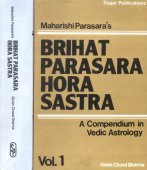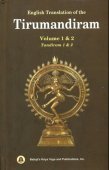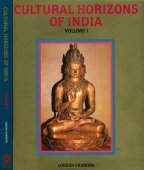Yogatantra: 5 definitions
Introduction:
Yogatantra means something in Buddhism, Pali, Hinduism, Sanskrit. If you want to know the exact meaning, history, etymology or English translation of this term then check out the descriptions on this page. Add your comment or reference to a book if you want to contribute to this summary article.
In Hinduism
Purana and Itihasa (epic history)
Source: Cologne Digital Sanskrit Dictionaries: The Purana IndexYogatantra (योगतन्त्र).—Authorship attributed to Viṣvaksena.*
- * Bhāgavata-purāṇa IX. 21. 26.

The Purana (पुराण, purāṇas) refers to Sanskrit literature preserving ancient India’s vast cultural history, including historical legends, religious ceremonies, various arts and sciences. The eighteen mahapuranas total over 400,000 shlokas (metrical couplets) and date to at least several centuries BCE.
In Buddhism
Tibetan Buddhism (Vajrayana or tantric Buddhism)
Source: OSU Press: Cakrasamvara SamadhiYogatantra (योगतन्त्र) refers to the “mode of meditation” and represents one of the divisions of Mahāyāna-Vajrayāna Buddhism, according to Buddhist teachings followed by the Newah in Nepal, Kathmandu Valley (whose roots can be traced to the Licchavi period, 300-879 CE).—Mahāyāna-Vajrayāna is commonly divided into four modes of practice, kriyā, "action", worshiping and serving a deity seen as outside oneself, caryā, "performance", embodying a deity by performing its ritual music and dance, yoga, "meditation", visualizing a deity or deities and absorbing them into oneself, and anuttarayoga, "the highest yoga", using sophisticated yogic meditation practices to actively turn oneself into an enlightened divinity. [...] Yoga Yogatantra and Anuttarayogatantra both involve the visualization and meditative absorption of a deity or deities, and the deities' retinue and mandala (samādhi). In Yogatantra, the object of one's meditation is usually a single deity such as Avalokiteśvara, or Ārya Tārā, "Green Tārā", whose supernatural strength and speed helps devotees overcome obstacles.

Tibetan Buddhism includes schools such as Nyingma, Kadampa, Kagyu and Gelug. Their primary canon of literature is divided in two broad categories: The Kangyur, which consists of Buddha’s words, and the Tengyur, which includes commentaries from various sources. Esotericism and tantra techniques (vajrayāna) are collected indepently.
Languages of India and abroad
Sanskrit dictionary
Source: Cologne Digital Sanskrit Dictionaries: Monier-Williams Sanskrit-English Dictionary1) Yogatantra (योगतन्त्र):—[=yoga-tantra] [from yoga] n. a [work] treating of the Yoga philosophy, [Harivaṃśa; Bhāgavata-purāṇa]
2) [v.s. ...] (with Buddhists) Name of a class of writings.
[Sanskrit to German]
Sanskrit, also spelled संस्कृतम् (saṃskṛtam), is an ancient language of India commonly seen as the grandmother of the Indo-European language family (even English!). Closely allied with Prakrit and Pali, Sanskrit is more exhaustive in both grammar and terms and has the most extensive collection of literature in the world, greatly surpassing its sister-languages Greek and Latin.
See also (Relevant definitions)
Partial matches: Yoga, Tantra.
Ends with: Anuttarayogatantra, Mantraprayogatantra, Mayajalamahayogatantra, Shikhayogatantra.
Full-text (+22): Anuttarayogatantra, Mayajalamahatantraraja, Namamantrarthavalokini, Mayajalatantra, Yoga, Tantra Yoga, Vajrabhairava, Cakrasamvaratantra, Samadhi, Amnaya, Patani, Marani, Akarshani, Narteshvari, Caryanritya, Giti, Caryagiti, Pandara, Nritya, Padmajvalini.
Relevant text
Search found 12 books and stories containing Yogatantra, Yoga-tantra; (plurals include: Yogatantras, tantras). You can also click to the full overview containing English textual excerpts. Below are direct links for the most relevant articles:
Blue Annals (deb-ther sngon-po) (by George N. Roerich)
Chapter 1 - Account of Yoga-tantras < [Book 7 - The preaching of the Tantras]
Chapter 1 - Secret Mantra In Jambudvīpa < [Book 10 - The Kālacakra]
Chapter 3 - Guhyasamāja-tantra system of Jñānapāda < [Book 7 - The preaching of the Tantras]
Guhyagarbha Tantra (with Commentary) (by Gyurme Dorje)
Text 8.17 (Commentary) < [Chapter 8 (text and commentary)]
Text 13.18 (Commentary) < [Chapter 13 (Text and Commentary)]
Text 3.18 (Commentary) < [Chapter 3 (text and commentary)]
Tibet (Myth, Religion and History) (by Tsewang Gyalpo Arya)
8. The Three Yanas < [Chapter 7 - Buddhism in Tibet]
9. The Highest Yoga Tantra < [Chapter 7 - Buddhism in Tibet]
10. Conclusion < [Chapter 7 - Buddhism in Tibet]
The Great Chariot (by Longchenpa)
Part 3 - Why they are the four tantras taught to those to be tamed < [A. Resolving the view]
Part 6 - The divisions of the three inner tantras < [A. Resolving the view]
Part 5 - How these are classified as the external secret mantra < [A. Resolving the view]
Parama Samhita (English translation) (by Krishnaswami Aiyangar)
Explanation of the name Pāñcarātra < [Introduction]
Varahi Tantra (English Study) (by Roberta Pamio)
Related products


